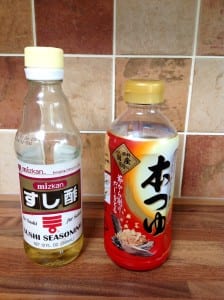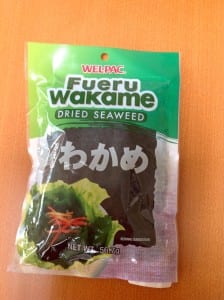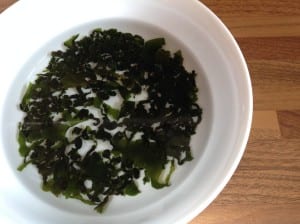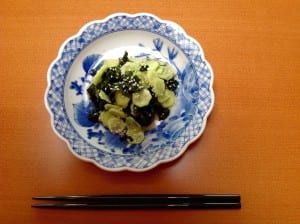This nutritious, quick to make and easy to digest dish is ideal when you’re on the go. It’s a little exotic too.
Every Tuesday I attend a yoga class and then have about half an hour at home for lunch before going out to teach myself. I need something very light but something that also gives me energy and goodness.
This Japanese seaweed and cucumber salad does the trick, perhaps with a small miso soup on the side. It also gives me the comfort of some of the flavours I grew up with. It reminds me of my mother’s home-cooking – always a good thing. Traditionally it’s eaten as a starter to clear the palate. Eaten on its own you’ll enjoy its freshness.
Below is a cheat’s version. I use these two ready-made products for the equivalent of a vinaigrette. You can find these in an Asian or Japanese food store, or I buy them online from the Japan Centre (the shop itself is in central London and is a lot of fun to visit and eat in). I use home-grown baby cucumbers from our allotment. They are lovely and crisp and flavoursome.

Ready-made sushi seasoning and dashi stock for the ‘vinaigrette’
All you need to do is mix 1 tablespoon of sushi seasoning with 1 teaspoon of dashi stock in a bowl. Add the drained wakame seaweed (about half a handful when dry) and as much – very finely sliced – cucumber as you like. Gently mix. I like to sprinkle this with some sesame seeds. It’s as simple as that.
The seaweed makes this a super-salad. Seaweed in its various forms is an everyday part of Japanese cuisine. It contains iron, calcium, phosphorous and iodine as well as being rich in vitamins A and C. It contains a high percentage of the carbohydrate that aids digestion. Cucumbers are one of the best food sources of the mineral silica, said to be one of the most important for skin health. They also provide vitamin C.
Outside Japan, wakame as used in this dish is sold in dry form. It keeps extremely well.
Wakame is vitamin-rich and contains zero fat. It has a delicate flavour. I find it refreshing and like its crispness. It needs to be soaked – for 5 minutes in cold water – before being eaten. It can go directly into a soup though. If you like, you can pour boiling water over it once you have drained it, and then immediately plunge it in cold water. This enhances its green colour.
Anecdotally, seaweed is also credited with keeping all that Japanese hair black when others turn to grey. I remember once watching a TV programme in which the chef Rick Stein visited Japan. One evening he dined with a former Japanese Prime Minister and some of his colleagues. The former PM was about 70 I believe, but retained his own head of black hair, as did his colleagues. Mr Stein was visibly astonished.
I hope you enjoy it.
If you liked this post and the dish please feel free to share it – and something a little exotic – with your friends.
Photos: author’s own


